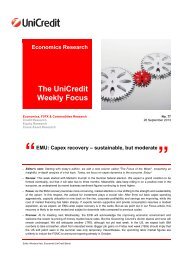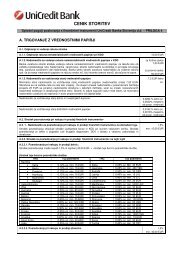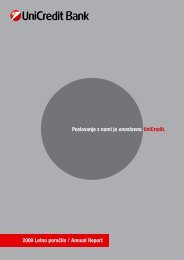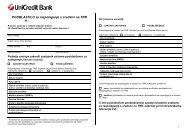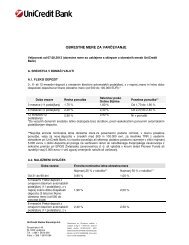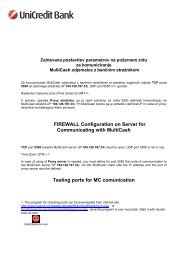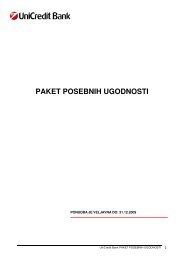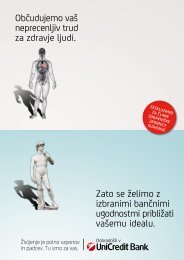Letno poroÄilo 2007 - UniCredit Banka Slovenija dd
Letno poroÄilo 2007 - UniCredit Banka Slovenija dd
Letno poroÄilo 2007 - UniCredit Banka Slovenija dd
Create successful ePaper yourself
Turn your PDF publications into a flip-book with our unique Google optimized e-Paper software.
(b) Loans and receivablesLoans and receivables are non-derivative financial assets with fixedor determinable payments that are not quoted in an active market,other than:• Those that the Bank intends to sell immediately or in the shortterm, which are classified as held for trading, and those that theBank upon initial recognition designates as at fair value throughprofit or loss• Those that the Bank upon initial recognition designates asavailable for sale; or• Those for which the holder may not recover substantially all of itsinitial investment, other than because of credit deterioration.Loans and receivables are carried at effective interest method. Aslong as the Bank did not apply program solution for recognizing feesfor corporate loans using effective interest method, those fees areaccrued linearly.The Bank assesses at each reporting date whether there is anyindication that an asset may be impaired. If any such indicationexists, the Bank estimates the recoverable amount of the asset.An individual assessment of financial assets is used for all loans,apart from private customers, where a portfolio assessment of thequality of a financial asset is applied.Insignificant third-party expenses, such as legal fees incurred insecuring a loan are treated as part of the cost of the transaction whilefor material third-party expenses they are amortised over the usefullife of the loan. All loans and receivables are recognised when cashis advanced to borrowers.(c) Held to maturity investmentsHeld to maturity investments are non-derivative financial assetswith fixed or determinable payments and fixed maturities that theBank has the positive intention and ability to hold to maturity. Thisportfolio comprises debt securities.Held-to-maturity investments are measured at effective interestmethod.The Bank assesses at each reporting date whether there is anyindication that an asset may be impaired. If any such indicationexists, the Bank estimates the recoverable amount of the asset.(d) Available-for-sale financial assetsAvailable-for-sale financial assets are those non-derivative financialassets that are designated as available for sale or are not classifiedas loans and receivables, held-to-maturity investments or financialassets at fair value through profit or loss. This portfolio includes bothequity and debt securities.Subsequent to their initial recognition, available-for-sale financialassets are remeasured at their fair value. In circumstances where thequoted market prices are not readily available, the fair value of debtsecurities is estimated using the present value of future cash flowsand the fair value of unquoted equity instruments is estimated usingapplicable price/earnings or price/cash flow ratios refined to reflectthe specific circumstances of the issuer.A gain or loss on an available-for-sale financial asset is recognise<strong>dd</strong>irectly in equity, through the statement of changes in equity, exceptfor impairment losses and foreign exchange gains and losses, untilthe financial asset is derecognised, at which time the cumulativegain or loss previously recognised in equity is recognised inprofit or loss. However, interest calculated are accrued daily usingthe effective interest method and is recognised in profit or loss.Dividends on an available-for-sale equity instruments are recognisedin profit or loss when the Bank’s right to receive payment isestablished.Derivative financial instrumentsIn the normal course of business, the Bank is a party to contractsfor derivative financial instruments, which represent a very lowinitial investment compared to the notional value of the contract.The derivative financial instruments used include interest rateand currency forward, swap and option contracts. These financialinstruments are used by the Bank to hedge interest rate risk andcurrency exposures associated with its transactions in financialmarkets, to open its positions actively and to sell those instrumentsto the customers.Derivative financial instruments are initially recognised at cost andsubsequently remeasured at their fair value. Fair values are obtainedfrom quoted market prices, discounted cash flow models and optionspricing models as appropriate. Changes in the fair value of derivativefinancial instruments that do not qualify for hedge accounting arerecognised in the ‘Gains and losses on financial assets and liabilitiesheld for trading’ as they arise. All derivatives are carried as assetswhen the fair value is positive and as liabilities when the fair value isnegative.<strong>UniCredit</strong> Bank · <strong>2007</strong> Annual Report 157



